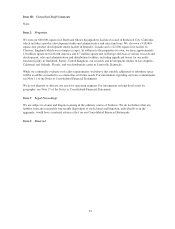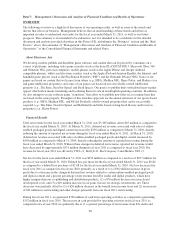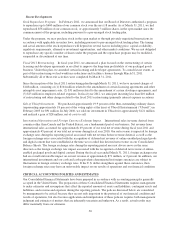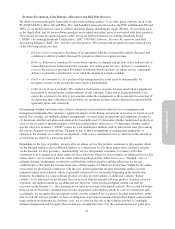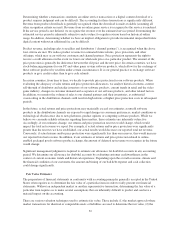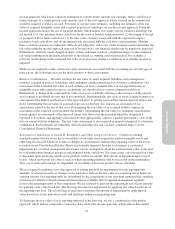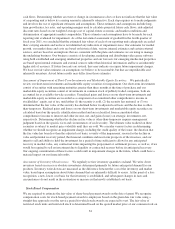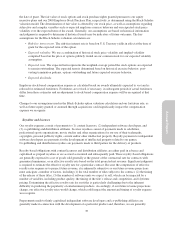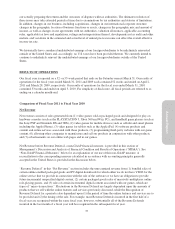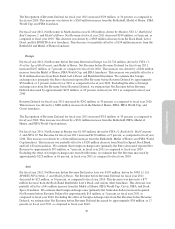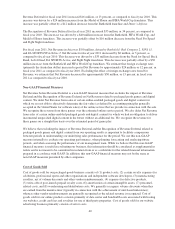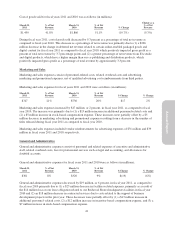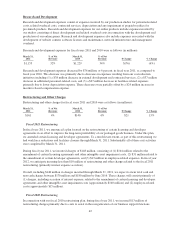Electronic Arts 2011 Annual Report Download - page 110
Download and view the complete annual report
Please find page 110 of the 2011 Electronic Arts annual report below. You can navigate through the pages in the report by either clicking on the pages listed below, or by using the keyword search tool below to find specific information within the annual report.cash flows. Determining whether an event or change in circumstances does or does not indicate that the fair value
of a reporting unit is below its carrying amount is inherently subjective. Each step requires us to make judgments
and involves the use of significant estimates and assumptions. These estimates and assumptions include long-
term growth rates, tax rates, and operating margins used to calculate projected future cash flows, risk-adjusted
discount rates based on our weighted average cost of capital, future economic and market conditions and
determination of appropriate market comparables. These estimates and assumptions have to be made for each
reporting unit evaluated for impairment. As of the last annual assessment of goodwill in the fourth quarter of
fiscal year 2011, we concluded that the estimated fair values of each of our reporting units adequately exceeded
their carrying amounts and we have not identified any indicators of impairment since. Our estimates for market
growth, our market share and costs are based on historical data, various internal estimates and certain external
sources, and are based on assumptions that are consistent with the plans and estimates we are using to manage
the underlying business. Our business consists of developing, marketing and distributing video game software
using both established and emerging intellectual properties and our forecasts for emerging intellectual properties
are based upon internal estimates and external sources rather than historical information and have an inherently
higher risk of accuracy. If future forecasts are revised, they may indicate or require future impairment charges.
We base our fair value estimates on assumptions we believe to be reasonable, but that are unpredictable and
inherently uncertain. Actual future results may differ from those estimates.
Assessment of Impairment of Short-Term Investments and Marketable Equity Securities. We periodically
review our short-term investments and marketable equity securities for impairment. Our short-term investments
consist of securities with remaining maturities greater than three months at the time of purchase and our
marketable equity securities consist of investments in common stock of publicly traded companies, both are
accounted for as available-for-sale securities. Unrealized gains and losses on our short-term investments and
marketable equity securities are recorded as a component of accumulated other comprehensive income in
stockholders’ equity, net of tax, until either (1) the security is sold, (2) the security has matured, or (3) we
determine that the fair value of the security has declined below its adjusted cost basis and the decline is other-
than-temporary. Realized gains and losses on our short-term investments and marketable equity securities are
calculated based on the specific identification method and are reclassified from accumulated other
comprehensive income to interest and other income, net, and gains (losses) on strategic investments, net,
respectively. Determining whether the decline in fair value is other-than-temporary requires management
judgment based on the specific facts and circumstances of each security. The ultimate value realized on these
securities is subject to market price volatility until they are sold. We consider various factors in determining
whether we should recognize an impairment charge, including the credit quality of the issuer, the duration that
the fair value has been less than the adjusted cost basis, severity of the impairment, reason for the decline in
value and potential recovery period, the financial condition and near-term prospects of the investees, and our
intent to sell and ability to hold the investment for a period of time sufficient to allow for any anticipated
recovery in market value, any contractual terms impacting the prepayment or settlement process, as well as, if we
would be required to sell an investment due to liquidity or contractual reasons before its anticipated recovery.
Our ongoing consideration of these factors could result in impairment charges in the future, which could have a
material impact on our financial results.
Assessment of Inventory Obsolescence. We regularly review inventory quantities on-hand. We write down
inventory based on excess or obsolete inventories determined primarily by future anticipated demand for our
products. Inventory write-downs are measured as the difference between the cost of the inventory and market
value, based upon assumptions about future demand that are inherently difficult to assess. At the point of a loss
recognition, a new, lower cost basis for that inventory is established, and subsequent changes in facts and
circumstances do not result in the restoration or increase in that newly established cost basis.
Stock-Based Compensation
We are required to estimate the fair value of share-based payment awards on the date of grant. We recognize
compensation costs for stock-based payment awards to employees based on the grant-date fair value using a
straight-line approach over the service period for which such awards are expected to vest. The fair value of
restricted stock units and restricted stock is determined based on the quoted market price of our common stock on
34


